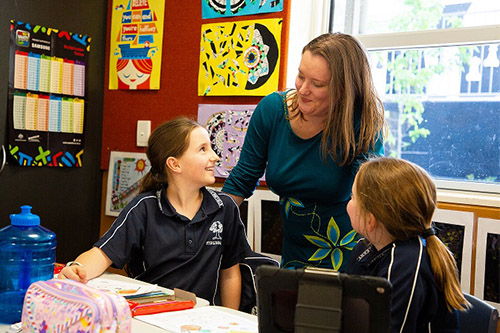
Last week, the recipients of the 2019 Prime Minister’s Prizes for Science were announced, revealing strong female representation among the nation’s leading thinkers in science, mathematics, innovation and technology research.
The $750,000 annual award gives out five prizes for science and innovation (the Science Prizes) and two for science, mathematics or technology teaching (the Science Teaching Prizes).
One of the winners was Stirling East Primary School teacher Sarah Finney, who took out the Prime Minister’s Prize for Excellence in Science Teaching in Primary Schools.
Finney’s philosophy is that scientific literacy and STEM understanding are essential to making informed and sensible decisions as human beings.
“I apply this philosophy to almost every aspect of my teaching,” Finney told The Educator.
“Firstly, I choose to use programs within the classroom which have been scientifically proven to have a sound basis in research.”
Finney said the school’s PLC uses Tierney Kennedy’s Back to Front Maths program and regularly evaluates its success by finding the effect size of our teaching based on John Hattie’s formula.
“If it did not achieve high results, we would abandon it but it has delivered effect sizes of 0.8 and over for most units, where an effect size of 0.4 is considered to be a greater than average effect size, and 0.6 is considered to be a large effect size,” she said.
“I model the scientific method within everyday teaching also.”
Teaching students to love science
Leading a science ‘inquiry unit’ Finney aims to introduce science in the minds of young students, challenging them to think more critically.
“I explicitly step the children through each part of the scientific method using scaffolded resources and lessons on each individual part of the process,” she explained.
“The very act of identifying a scientific question or problem takes the children about six weeks, and there is a lot of critical analysis even in this basic first step.”
Finney said children have to identify something which interests them, then generate questions about this topic, learn about what makes a scientific question and finally examine their list to see if any of their questions are suitable for scientific analysis.
“Children are explicitly taught about variables, controls, sample sizes, and biases, and plan their experiments taking these critical factors into account. They gather data, represent, analyse and draw conclusions,” she said.
“The end step of the report is to reflect on whether or not they have completed a fair test, and to identify which audience might find their research compelling.”
Finney said her school celebrates students’ work by communicating their findings both to their parents and peers, and also to scientists and science experts who offer feedback on their research.
“Following this, children take all feedback into account and reflect on how to improve their research skills for next year,” Finney said.
“There is huge growth between the year three and four results each year and the year fours are able to critically analyse and assist the year threes.”
Finney said engaging in real life science about a topic of interest and reflecting on its success is “the first step in thinking like a scientist”.
“Often throughout the rest of the year I share scientific reports to my class, or we engage in further studies on different topics,” she said.
“Students can ask critical and appropriate questions about whether or not the activity describes a fair test, and I smile, because I know that I have helped to foster those essential analytical skills.”
The 2019 recipients of the Prime Minister’s Prizes for Science are:
Prime Minister’s Prize for Science:
Emeritus Professor Cheryl Praeger AM, The University of Western Australia
Prime Minister’s Prize for Innovation:
Professor David Huang, Professor Andrew Roberts, Professor Guillaume Lessene and Associate Professor Peter Czabotar, Walter & Eliza Hall Institute of Medical Research
Frank Fenner Prize for Life Scientist of the Year:
Associate Professor Laura Mackay, The University of Melbourne
Malcolm McIntosh Prize for Physical Scientist of the Year:
Associate Professor Elizabeth New, The University of Sydney
Prize for New Innovators
Dr Luke Campbell, Nura Operations Pty Ltd, Victoria
Prime Minister’s Prize for Excellence in Science Teaching in Primary Schools:
Mrs Sarah Finney, Stirling East Primary School, South Australia
Prime Minister’s Prize for Excellence in Science Teaching in Secondary Schools:
Dr Samantha Moyle, Brighton Secondary School, South Australia


